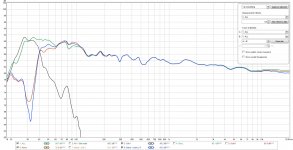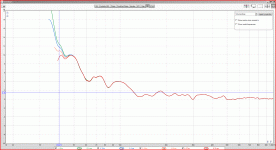Is the sub adding or subtracting from the signal above 40 Hz.
If it's subtracting it isn't really in phase, if it's adding it is...
I didn't misunderstand you here... that's why I added; only if you want to.
I remembered the fixed slope. But that doesn't mean everything is actually in phase and adding to the signal the way you have it setup.
If it is adding and providing a nice bridge between the 2 rolled off drivers you're all set. It's that simple.
If it's subtracting it isn't really in phase, if it's adding it is...
I didn't misunderstand you here... that's why I added; only if you want to.
I remembered the fixed slope. But that doesn't mean everything is actually in phase and adding to the signal the way you have it setup.
If it is adding and providing a nice bridge between the 2 rolled off drivers you're all set. It's that simple.
Last edited:
Not bad at all, you do see how the peak from the sub (80 Hz) is out of phase and actually subtracting from the mains. No big problem as you had a bump there otherwise. Same can be seen on the lowest end. But very close to perfect.
Nice! Looks like you're winning on this journey of yours. Satisfied?
Nice! Looks like you're winning on this journey of yours. Satisfied?
Not bad at all, you do see how the peak from the sub (80 Hz) is out of phase and actually subtracting from the mains. No big problem as you had a bump there otherwise. Same can be seen on the lowest end. But very close to perfect.
Nice! Looks like you're winning on this journey of yours. Satisfied?
I am not sure.
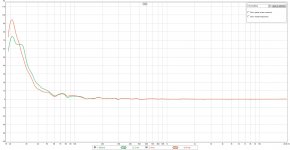
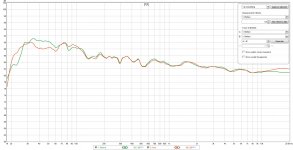
Which would you rather have?
Orange or Green? (anyone answer)
Last edited:
I'd say green based on FR, orange based on GD 😀.
But only you can hear it. And it's difficult at that. There are going to be differences but is it the timing you hear? Or less really low bass putting the emphasis on the part above it.
Which do you like, that is the question. Not an easy one I presume?
Edit: I like the low extension of the orange one. On some music it's wonderful to have that low roar at 20 Hz, not really to hear it, but you definitely feel it! Based on that the orange one could win me over. As long as you feel nothing is missing. I reduced output of my arrays at 20 Hz, sloping down from 30 Hz.
But some pieces of music never felt the same. Even though there's still output there, it's not flat to 20 Hz anymore and I miss it a bit. Yet I'm afraid of letting my little cones do that for me, just for that feel. I want to keep them I think. A sub or 2 or 3 might be in my future. All sealed of coarse.
But only you can hear it. And it's difficult at that. There are going to be differences but is it the timing you hear? Or less really low bass putting the emphasis on the part above it.
Which do you like, that is the question. Not an easy one I presume?
Edit: I like the low extension of the orange one. On some music it's wonderful to have that low roar at 20 Hz, not really to hear it, but you definitely feel it! Based on that the orange one could win me over. As long as you feel nothing is missing. I reduced output of my arrays at 20 Hz, sloping down from 30 Hz.
But some pieces of music never felt the same. Even though there's still output there, it's not flat to 20 Hz anymore and I miss it a bit. Yet I'm afraid of letting my little cones do that for me, just for that feel. I want to keep them I think. A sub or 2 or 3 might be in my future. All sealed of coarse.
Last edited:
I'd say green based on FR, orange based on GD 😀.
But only you can hear it. And it's difficult at that. There are going to be differences but is it the timing you hear? Or less really low bass putting the emphasis on the part above it.
Which do you like, that is the question. Not an easy one I presume?
Thats the thing. I knew what FR differences sound like. But didnt know what low GD did. So I had to go all out to lower the GD to get a sense of what that sounded like. As you noticed, I had to sacrifice the FR I wanted to achieve the lower GD.
The idea I am toying with right now is to use a RLC notch filter on the woofers of the mains to bring down the 70-110hz energy 1.5 - 2db or so on the Orange FR.
Listening to it both ways, the charts pretty much tell the story. I like the bass tightness of the Orange, but the FR of the Green.
I know, its been a long thread. But we have already covered this. Yes, its needed (I'll explain it again if you want).
I'm at 10.7ms of GD at 40hz. Thats less than 1/2 a cycle. You really think it needs to be 5ms shorter?
View attachment 489063
Sorry I missed it. I only said it because I did the same thing and saved myself 5ms at 35Hz.
For us DRC users that's just drawing a different target curve. But you know that.
I can imagine what you're after, a bit more balance but a different slope to get the group delay. Was it worth the journey so far? As a learning experience, yes of coarse, but in listening? I'd gamble: yes.
But I wouldn't know. I'm only partially there in my cluttered living room.
I can imagine what you're after, a bit more balance but a different slope to get the group delay. Was it worth the journey so far? As a learning experience, yes of coarse, but in listening? I'd gamble: yes.
But I wouldn't know. I'm only partially there in my cluttered living room.
For us DRC users that's just drawing a different target curve. But you know that.
I can imagine what you're after, a bit more balance but a different slope to get the group delay. Was it worth the journey so far? As a learning experience, yes of coarse, but in listening? I'd gamble: yes.
But I wouldn't know. I'm only partially there in my cluttered living room.
I am still deciding what I want. But the journey certainly has been worth it. As for FR, Greg seems happy at -6db at 60hz and -9db at 32hz (to the best of my memory) and he seems happy with it. For me, I am used to +4.5 at 60hz and +6db at 32hz (in reference to 200hz)
So I dont know. I do know it will be hard to give up the bass tightness now that I have some. Maybe I can get used to +2.5db at 60hz and +3.5db at 32hz ????
Yea, you DRC guys have simpler solutions to this. I have to get out my soldering iron and take my speaker apart to do a minor FR change 🙁
Last edited:
People always say you don't hear that small a difference. I don't think I agree to that. It's a balance thing. Removing the 70-110 Hz might give back balance to prefer it over the previous bass.
You'll have to get used to the new balance after that I guess. It will sound different anyway with the tight bass. Play some nice drum tracks first, Eyes closed. What sounds more real, visceral... that would be my winner.
You'll have to get used to the new balance after that I guess. It will sound different anyway with the tight bass. Play some nice drum tracks first, Eyes closed. What sounds more real, visceral... that would be my winner.
People always say you don't hear that small a difference. I don't think I agree to that. It's a balance thing. Removing the 70-110 Hz might give back balance to prefer it over the previous bass.
You'll have to get used to the new balance after that I guess. It will sound different anyway with the tight bass. Play some nice drum tracks first, Eyes closed. What sounds more real, visceral... that would be my winner.
Very good advice

Last edited:
Nope!
My guess is that as the starting freq of the sweep moves towards zero, the accuracy of the measurement improves...
My guess is that as the starting freq of the sweep moves towards zero, the accuracy of the measurement improves...
IR measurement is a map that gives the relative amplitude and phase of all sine waves within the measurement bandwidth. GD is first derivative of phase. Absolute phase of all frequency components are measured relative to point chosen as t=0 for given signal.
REW: When upper and lower frequencies are chosen for a sweep measurement, the software limits display data to only within the selected sweep endpoints. For sweeps starting below 20Hz REW generates a sweep with corresponding inverse that is capable of measuring to DC point. For sweeps with 20Hz and up start point REW creates sweeps with brickwall high pass filter. All this is readily observed when digital loopback measurements are made with REW.
Gating: term is used very loosely. I see the term applied and often from displayed results it is clear to me that a gated response is not being used. A gated response is rectangular window. All values outside window are truncated to zero. Windowing that does not fully capture high pass filter behavior of IR induces low frequency ripple in the observed frequency response.
REW generates all displays by applying calculations to measurement's current windowing. Only samples within window are used. For rectangular window actual sample values are used; otherwise the windowed sample values are used.
Here is digital loop back GD measurement using 44.1kHz sample rate with sweep start 35Hz, sweep end 22050Hz using 512k length setting with 25ms rectangular windowing starting at IR peak centered at t=0:
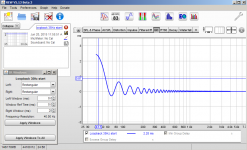
REW: When upper and lower frequencies are chosen for a sweep measurement, the software limits display data to only within the selected sweep endpoints. For sweeps starting below 20Hz REW generates a sweep with corresponding inverse that is capable of measuring to DC point. For sweeps with 20Hz and up start point REW creates sweeps with brickwall high pass filter. All this is readily observed when digital loopback measurements are made with REW.
Gating: term is used very loosely. I see the term applied and often from displayed results it is clear to me that a gated response is not being used. A gated response is rectangular window. All values outside window are truncated to zero. Windowing that does not fully capture high pass filter behavior of IR induces low frequency ripple in the observed frequency response.
REW generates all displays by applying calculations to measurement's current windowing. Only samples within window are used. For rectangular window actual sample values are used; otherwise the windowed sample values are used.
Here is digital loop back GD measurement using 44.1kHz sample rate with sweep start 35Hz, sweep end 22050Hz using 512k length setting with 25ms rectangular windowing starting at IR peak centered at t=0:

IR measurement is a map that gives the relative amplitude and phase of all sine waves within the measurement bandwidth. GD is first derivative of phase. Absolute phase of all frequency components are measured relative to point chosen as t=0 for given signal.
REW: When upper and lower frequencies are chosen for a sweep measurement, the software limits display data to only within the selected sweep endpoints. For sweeps starting below 20Hz REW generates a sweep with corresponding inverse that is capable of measuring to DC point. For sweeps with 20Hz and up start point REW creates sweeps with brickwall high pass filter. All this is readily observed when digital loopback measurements are made with REW.
Gating: term is used very loosely. I see the term applied and often from displayed results it is clear to me that a gated response is not being used. A gated response is rectangular window. All values outside window are truncated to zero. Windowing that does not fully capture high pass filter behavior of IR induces low frequency ripple in the observed frequency response.
REW generates all displays by applying calculations to measurement's current windowing. Only samples within window are used. For rectangular window actual sample values are used; otherwise the windowed sample values are used.
Here is digital loop back GD measurement using 44.1kHz sample rate with sweep start 35Hz, sweep end 22050Hz using 512k length setting with 25ms rectangular windowing starting at IR peak centered at t=0:
View attachment 489504
In answer to the bolded area, it this to say that REW sweeps should always start below 20hz as to not induce frequency ripple? (when analyzing low frequency GD).
Is the default settings in REW sufficient to capture the high pass filter behavior of the IR? (those settings besides the sweep frequency which is addressed above) ? For instance the gate settings (left and right window lengths) ?
As for the rest, I thank you for a very thorough response. But I am not sure I am getting your intended point. Is there a conclusion you draw as to GD accuracy based on sweep frequency width? I see your "ripple" pic.
Is what your saying as simple as; Sweep lengths that begin 20hz or above are subject to "frequency ripple", making GD measurements less accurate. And I guess the further you are from 20hz, the bigger the ripple?
Last edited:
This thread has provoked some ideas. One among them is how when we alter the signal path, we usually incur consequences. Looking at "Digital vs Analog", certainly argument can be given to the trade offs involved with both.
Among those on the Analog side, their strongest argument concerns how real, genuine, or natural the sound is. The best analog stills argues its approach preserves this better than digital. I realize this argument isn't as valid as it once was. But it still points out that what, and in what way we alter the signal path gives and takes away certain things. But different things.
In my reflections on what DRC sounded like, it was similar in some ways to the D and A arguments. DRC correction, especially when used heavily, takes away (IMO), some more of what the Analog people argue (believability?)(convincing?). While at the same time, it improved other areas.
Among those on the Analog side, their strongest argument concerns how real, genuine, or natural the sound is. The best analog stills argues its approach preserves this better than digital. I realize this argument isn't as valid as it once was. But it still points out that what, and in what way we alter the signal path gives and takes away certain things. But different things.
In my reflections on what DRC sounded like, it was similar in some ways to the D and A arguments. DRC correction, especially when used heavily, takes away (IMO), some more of what the Analog people argue (believability?)(convincing?). While at the same time, it improved other areas.
I honestly don't think that brief test showed you what digital is capable of.
To really know that would take a lot more experimenting i.m.h.o.
To really know that would take a lot more experimenting i.m.h.o.
The easiest definition to understand that ive seen is this:
I'll offer this layman's definition: Group delay (GD) can be thought of as
related to the time elapsed between a signal of a specific frequency applied to the driver and the cone's
attempt to recreate that stimulus, as compared to the next adjacent frequency. (And the next -ad infinum.)
This delay is a function of the phase of the system at those frequencies. For a constant group delay, and
freedom from waveform distortion, the system phase has to change linearly with the frequency response.
group_delay
What this seems to be saying is that if your FR matches your phase curve, you will keep GD to a minimum. Hmmmm.
Sorry to barge into this thread like this, but I am affraid there are at least three misconceptions in this definition:
1) group delay is nothing but the slope of the phase curve, with the latter set out on a linear scale. It is d(phase shift)/d(frequency).
2) it is not directly related to the time elapsed between a signal of a specific frequency applied to the driver and the cone. If you want to know this delay, the appropriate calculation is (phase shift/360 degrees)/frequency. The ms in group delay has no bearing on any delay that can be observed in the real world. I will repost some measurements I showed on another post shortly. In it, you can see that group delay can become negative, even when there is a delay between signal and cone movement.
3) for a constant group delay, the system has to be either linear phase, or has to change linearly with the frequency response in the kind of minimum phase system that doesn't exist in the wild. One of the problems with group delay as a measure is that it treats 1 Hz @ 40 Hz the same as 1 Hz @ 20KHz. Real filter slopes do not work like this, they always treat Hz on a logarithmic scale. It is so many dB per octave or decade (Hz on a log scale), never so many dB per Hz. So, in real systems, group delay figures get heavily skewed towards the low end, without any technical or psycho-acoustical reason. It is much better and easier to look at phase shift per octave as a relevant measurement with normal drivers and xovers.
The only reason to take the slope of the phase curve into account is when you want to pull funky stuff with eleptical filters. These have steep slopes and an enormous phase flip flop in the middle of their band. However, it is still not good to use group delay, because this measure is not normalized for Hz on a log scale. The only appropriate measure here would be d(phase shift)/d(log(Hz)).
And rereading all this I stumble over a 4th misconception:
4) Only with linear phase there will not be any group delay and no wave form distortion. However, one could probably build a DSP filter that exhibits a constant positive or negative group delay. In those cases, however, there would be phase shift and hence wave form distortion.
P.s. since our auditory system is not an oscilloscope, but for the most part an audio analyzer, wave form distortion is virtually a non-issue. We don't hear wave forms, but pick up on sound pressure in different frequency bands. The area in the frequency band where we are sensitive to timing differences (zero crossings) is quite limited, and within that band we appear to compensate readily for stationary phase shifts.
Last edited:
[Light bulb going off] Of course! Since Group Delay is d(phase)/d(frequency), a linear phase system will have constant Group Delay because the derivative of a constant slope is a constant! And the steeper that (constant) slope, the higher the (constant) Group Delay! Wow!
Jan
Jan
- Status
- Not open for further replies.
- Home
- Loudspeakers
- Full Range
- Group Delay Questions and Analysis
